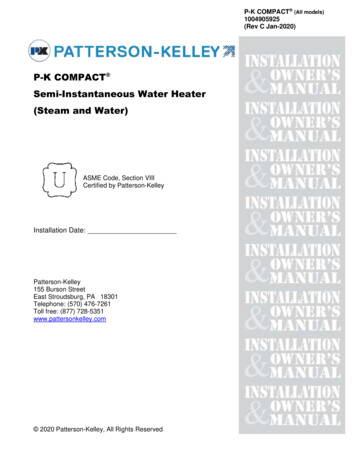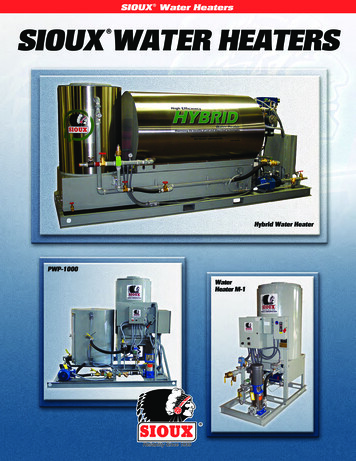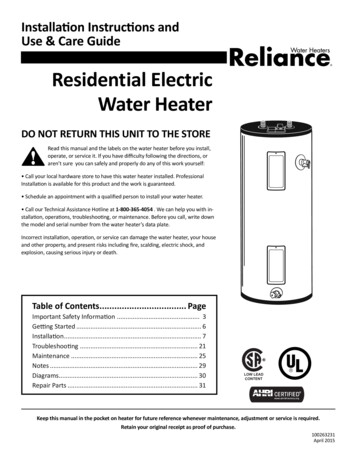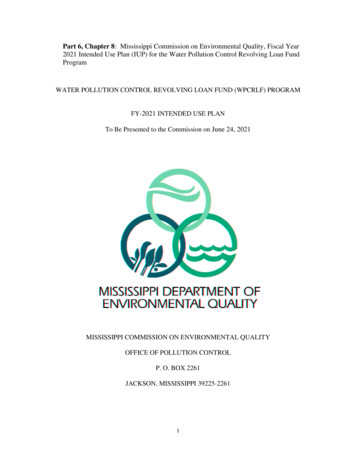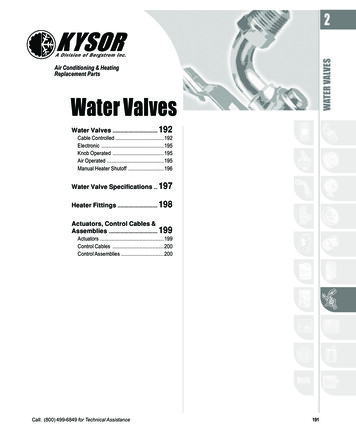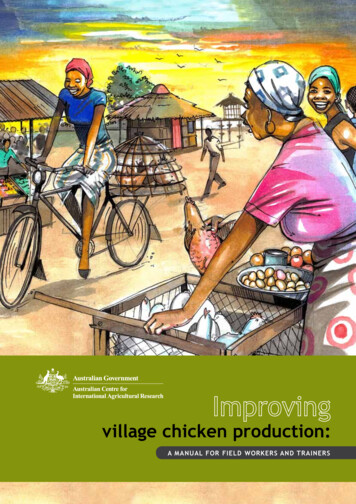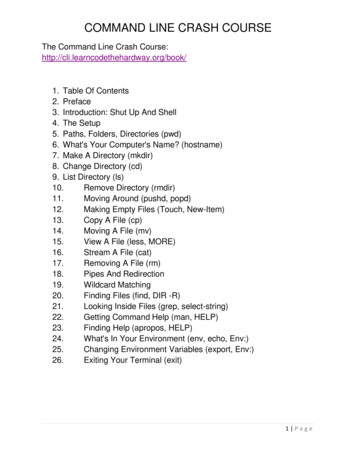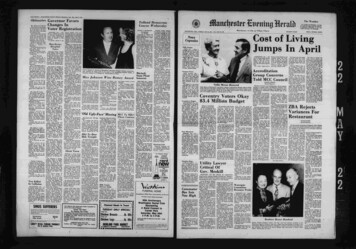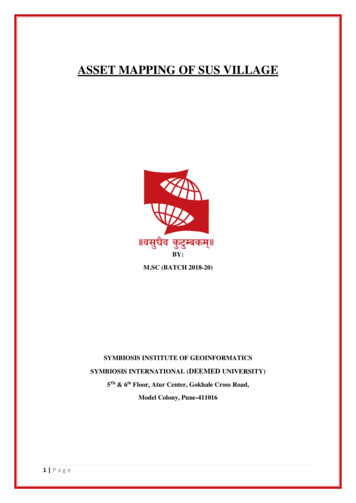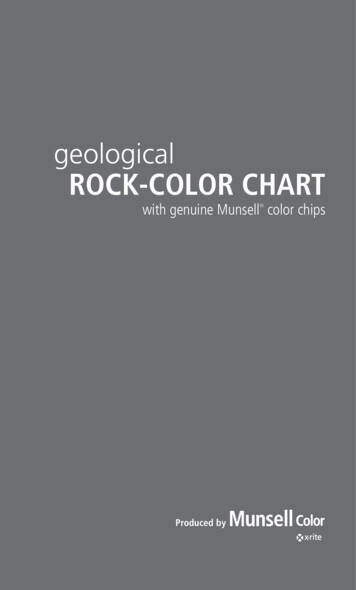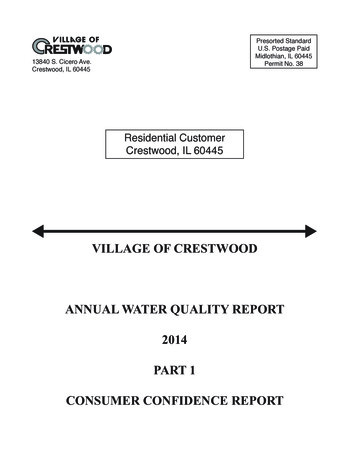
Transcription
Presorted StandardU.S. Postage PaidMidlothian, IL 60445Permit No. 3813840 S. Cicero Ave.Crestwood, IL 60445Residential CustomerCrestwood, IL 60445VILLAGE OF CRESTWOODANNUAL WATER QUALITY REPORT2014PART 1CONSUMER CONFIDENCE REPORT
This report summarizes the quality of water that we provided in 2014, including details aboutwhere your water comes from, what it contains, and how it compares to standards set be theregulatory agencies.If you have any questions about this report or concerning your water system, please contact The Village ofCrestwood, at 708-371-4800. We want our valued customers to be informed about their water quality. If youwould like to learn more, please feel welcome to attend any of our regular scheduled meetings on the first andthird Thursday of every month at 8:00 p.m. at the Crestwood Civic Center, 14025 S. Kostner Ave.,Crestwood, Illinois.Village of Crestwood water source: The Village of Crestwood purchases water from the Village of Alsip,which is supplied by the City of Chicago.Drinking water, including bottled water, may reasonably be expected to contain at least small amounts ofsome contaminants. The presence of contaminants does not necessarily indicate that water poses a health risk.More information about contaminants and potential health effects can be obtained by calling the USEPA'sSafe Drinking Water Hotline (1-800-426-4791).Some people may be more vulnerable to contaminants in drinking water than the general population.Immuno-compromised persons such as persons with cancer undergoing chemotherapy, persons who haveundergone organ transplants, people with HIV/AIDS or other immune system disorders, some elderly, andinfants can be particularly at risk from infections. These people should seek advice about drinking water fromtheir health care providers. USEPA/CDC guidelines on appropriate means to lessen the risk of infection byCryptosporidium and other microbial contaminants are available from the USEPA's Safe Drinking WaterHotline (1-800-426-4791).The sources of drinking water (both tap water and bottled water) include rivers, lakes, streams, ponds,reservoirs, springs and wells. As water travels over the surface of the land or through the ground, it candissolve naturally occurring minerals and radioactive materials, and pick up substances resulting from thepresence of animals or human activity. Possible contaminants consist of:-Microbial Contaminants, such as viruses and bacteria, which may come from sewage treatment plants, septic systems,agricultural livestock operations and wildlife;Inorganic Contaminants, such as salts and metals, which may be naturally occurring or result from urban storm waterrunoff, industrial or domestic wastewater discharges, oil and gas production, mining or farming;Pesticides and Herbicides, which may come from a variety of sources such as agriculture, urban storm water runoffand residential use;Organic Chemical Contaminants, including synthetic and volatile organic chemicals, which are by-products ofindustrial process and petroleum production, and may also come from gas stations, urban storm water runoff and septicsystems; andRadioactive Contaminants, which may be naturally occurring or be the result of oil and gas production and miningactivities.In order to ensure that tap water is safe to drink, USEPA prescribes regulations that limit the amount ofcertain contaminants in water provided by public water systems. FDA regulations establish limits forcontaminants in bottled water, which must provide the same protection for public health.
PART 2CONSUMER CONFIDENCE REPORT
Water Quality Data Table FootnotesTURBIDITYTurbidity is a measure of the cloudiness of the water. We monitor it because it is a good indicator of water quality and the effectiveness of ourfiltration system and disinfectants.UNREGULATED CONTAMINANTSA maximum contaminant level (MCL) for this contaminant has not been established by either state or federal regulations, nor has mandatoryhealth effects language. The purpose for monitoring this contaminants is to assist USEPA in determining the occurrence of unregulatedcontaminants in drinking water, and weather future regulation is warranted.FLUORIDEFluoride is added to the water supply to help promote strong teeth. The Illinois Department of Public Health recommends an optimal fluoriderange of 0.9 mg/l to 1.2 mg/l.SODIUMThere is no state or federal MCL for sodium. Monitoring is required to provided information to consumers and health officials who have concernsabout sodium intake due to dietary precautions. If you are on a sodium-restricted diet, you should consult a physician about the level of sodium inthe water.CITY OF CHICAGO, DEPARTMENT OF WATER MANAGEMENTSOURCE WATER ASSEMENT SUMMARYFOR THE 2014 CONSUMER CONFIDENCE REPORT (CCR)Source Water LocationThe City of Chicago utilizes Lake Michigan as its source water via two water treatment plants. The Jardine Water Purifications Plant serves thenorthern areas of the City and suburbs, while the South Water Purification Plant serves the southern areas of the City and suburbs. Lake Michiganis the only Great Lake is entirely contained within the United States. Its boarders Illinois, Indiana, Michigan, and Wisconsin, and is the secondlargest Great lake by volume with 1,180 cubic miles of water and third largest by area.Source Water Assessment SummaryThe Illinois EPA implemental a Source Water Assessment Program (SWAP) to assist with watershed protection of public drinking water supplies.The SWAP inventories potential sources of contamination and determined the susceptibly of the source water to contamination. The Illinois EPAhas completed the Source Water Assessment Program for our supply. Further information on our community water supply Source WaterAssessment Program is available by calling the City of Chicago, Department of Water Management at 312-744-6635.Susceptibility to ContaminationThe Illinois EPA considers all surface water sources of community water supply to be susceptible to potential pollution problems. The very natureof surface water allows contaminants to migrate into the intake with no prospection only dilution. This is the reason for mandatory treatment of allsurface water supplies in Illinois. Chicago’s offshore intakes relocated at a distance that shoreline impacts are not usually considered a factor onwater quality. At certain times of the year, however, the potential for contamination exits due to wet-weather flows and river reversals. In addition,the placement of the crib structures may serve to attract waterfowl, gulls and terns that frequent the Great Lake area, thereby concentrating fecaldeposits at the intake and thus compromising the source water quality. Conversely, the shore intake are highly susceptible to storm water runoff,marinas and shoreline point source due to the influx of groundwater to the lake.Further information on our community water supply’s Source Water Assessment Program is available by calling the City Chicago Department ofWater Management at 312-744-6635.2014 VOLUNTARY MONITORINGThe City of Chicago has continued monitoring for Cryptosporidium, Giardia and E. coli in its source water as part of its water quality program. Todate, Cryptosporidium has not been detected in these samples, but Giardia was detected in 2010 in one raw lake water samples, collected inSeptember 2010. Treatment process have been optimized to provided effective barriers for removal of Cryptosporidium oocysts and Giardia cystsin the source water, the possibility of Cryptosporidium and Giardia organisms getting into the drinking water system is greatly reduced.In 2013, CDWM has also continued monitoring for hexavalent chromium, also known as chromium-6. USEPA has not yet established a standardfor chromium-6, a contaminant of concern which has both natural and industrial sources. Please address any questions or concerns to DWM’sWater Quality Division at 312-742-7499. Data reports on the monitoring program for chromium-6 are posted on the City’s website which can beaccessed at the following address er/supp info/water quality resultsandreports/city of chicago emergincontaminantstudy.html2014 Violation Summary TableWe are pleased to announce that no monitoring reporting, treatment technique, maximum residual disinfectant level, or maximum contaminantlevel violation were recorded during 2014.
Crestwood, at 708-371-4800. We want our valued customers to be informed about their water quality. If you would like to learn more, please feel welcome to attend any of our regular scheduled meetings on the first and third Thursday of every month at 8:00 p.m. at the Crestwood Civic Center, 140

